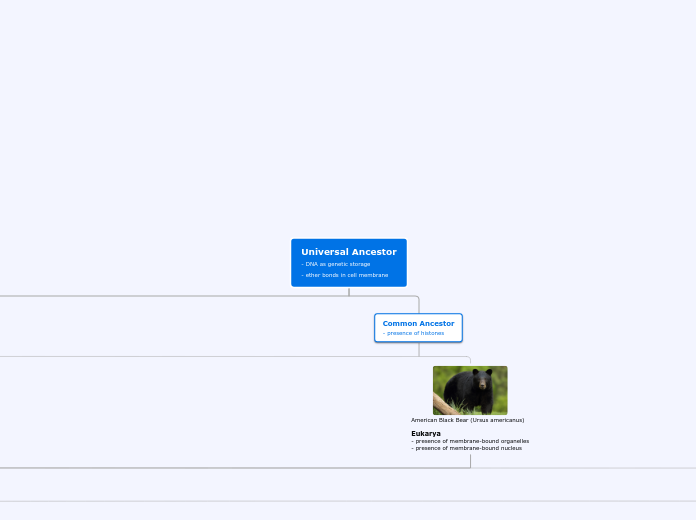によって Taylor Johnson 5年前.
296
Tree organigram
The text explores the evolutionary lineage of various life forms, beginning with the universal ancestor characterized by DNA as the genetic material and ether bonds in cell membranes.

によって Taylor Johnson 5年前.
296

もっと見る
Opisthokonta - single posterior flagellum on swimming cells
Animals - multicellularity - absorptive heterotroph - mobility - complex organ systems - gametic life cycle
Giant Barrel Sponge (Xestospongia muta) Porifera
Eumetazoa
Moon Jelly (Aurelia aurita) Cnidaria - diploblasty - radial symmetry
Medusozoa
Pennaria disticha Hydrozoa - polyp and medusa
Moon Jelly (Aurelia aurita) Scyphozoa - usually only medusa
Elkhorn coral (Acropora palmata) Anthozoa - usually only polyp
Bilateria
Deuterostomia - radial and indeterminate cleavage
Chordata - notochord - dosal nerve cord - pharyngeal slits - endostyle
Branchiostoma lanceolatum Cephalochordata - notochord - hollow dorsal nerve cord - pharyngeal slits - post-anal tail
Sea Peaches (Halocynthia aurantium) Urochordata - notochord - hollow dorsal nerve cord - pharyngeal slits - post-anal tail
Vertebrates
Agathans - notochord - hollow dorsal nerve cord - pharyngeal slits - post-anal tail - cranium - vertebral column - cartilaginous skeleton - ectothermic
Chondrichthyes - notochord - hollow dorsal nerve cord - pharyngeal slits - post-anal tail - cranium - vertebral column - jaws - cartilaginous skeleton - ectothermic
Actinopterygii (ray-finned fishes) - notochord - hollow dorsal nerve cord - pharyngeal slits - post-anal tail - cranium - vertebral column - jaws - bony skeleton - lungs or lung derivatives - ectothermic
Lobe-finned fishes - notochord - hollow dorsal nerve cord - pharyngeal slits - post-anal tail - cranium - vertebral column - jaws - bony skeleton - lungs or lung derivatives - ectothermic
Amphibia - notochord - hollow dorsal nerve cord - pharyngeal slits - post-anal tail - cranium - vertebral column - jaws - bony skeleton - lungs or lung derivatives - limbs - ectothermic
Reptilia - notochord - hollow dorsal nerve cord - pharyngeal slits - post-anal tail - cranium - vertebral column - jaws - bony skeleton - lungs or lung derivatives - limbs - ectothermic (non-bird reptiles) - endothermic (birds) - amniotic egg
Mammalia - notochord - hollow dorsal nerve cord - pharyngeal slits - post-anal tail - cranium - vertebral column - jaws - bony skeleton - lungs or lung derivatives - limbs - endothermic - amniotic egg - hair - milk
Giant Sea Star (Pisater giganteus) Enchinodermata - spiny skin - water vascular system - adults radially symmetrical, larvae are bilaterally symmetrical - no brain - complete digestive tract
California sea cucumber (Apostichopus californicus) Holothuroidea
Asteroidea
Serpent Star (Ophiura ophiura) Ophiuroidea
Purple Sea Urchin (Strongylocentrotus purpuratus) Enchinoidea
Protostomia - spiral and determinate cleavage - blastopore becomes mouth
Lophotrochozoa - trochophore and/or lophophore larvae
Pork Tapeworm (Taenia solium) Platyhelmnithese - acoelomates - incomplete digestive tract - no respiratory or circulatory systems
Pork Tapeworm (Taenia solium) Cestoda (Tapeworms) - parasitic - no digestive tract
Macrostomum lignano Rhabditophorans (Free-living)
Sheep Liver Fluke (Fasciola hepatica) Trematoda - parasitic
Common ancestor
Mollusca - soft-bodied - foot, visceral mass, mantle - coelomates - organ systems
Soft Shell Clam (Mya arenaria) Bivalvia - two-part shell
Humboldt squid (Dosidicus gigas) Cephalopoda - reduced or absent shell (except nautilus) - closed circulatory system
Golden Apple Snail (Pomacea canaliculata) Gastropoda
Common Earthworm (Lumbricus terrestris) Annelida - segmented worms - closed circulatory system - complete digestive tract
Ecdysozoa - metamorphosis (most) - ecdysis
Anthropoda - "jointed foot" - segmented - exoskeleton made of chitin - complete digestive tract - open circulatory system
Pancrustaceans
Monarch butterfly (Danaus plexippus) Hexapoda - six legs - insects - many have wings (crucial to their success as a group) - head, thorax, abdomen
Chesapeake Blue Crab (Callinectes sapidus) Crustaceans - cephalothorax
Southern Black Widow (Latrodectus mactans) Chelicerates - cephalothorax and abdomen - 4 pairs of walking legs, pedipalps, and chelicerae
Roundworm (Caenorhabditis elegans) Nematodoa - free-living and parasitic - cuticle - pseudocoelom - complete digestive tract
Fungi - multicellularity - absorptive heterotroph - cell wall - zygotic life cycle
slime molds Amebozoa - movement with pseudopodia
Rhizaria - filose pseudopodia
radiolarians
foraminiferas
dinoflagellates Alveolata - membranous vesicles on cell membrane - secondary plastids
Stramenopila - tripartite flagellar hair - secondary plastids
diatoms
giant kelp
Fly Agaric
euglenoids
Plants
Angiosperms - pollen - seed - fruit - flowers - endosperm - heterospory - wood - ovules - ovaries
Gymnosperms - pollen - seed - heterospory - wood - ovules
Monilophytes - sporic life cycle - embryo - desiccation resistant spores - apical meristems - gametangia - sporangia - lignin - xylem and phloem - megaphylls - dominant sporophyte generation - thick waxy cuticle - stomata
Lycophytes - sporic life cycle - embryo - desiccation resistant spores - apical meristems - gametangia - sporangia - lignin - xylem and phloem - leaves (lycophylls) - dominant sporophyte generation - thick waxy cuticle - stomata
Hornworts - sporic life cycle - embryo - desiccation resistant spores - apical meristems - gametangia - sporangia
Mosses - sporic life cycle - embryo - desiccation resistant spores - apical meristems - gametangia - sporangia
Liverworts - sporic life cycle - embryo - desiccation resistant spores - apical meristems - gametangia - sporangia
Charophytes
Common Ancestor
chlorophytes
rhodophytes